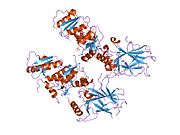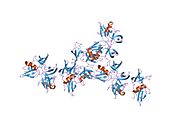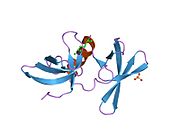TP53BP1
| TP53BP1 | |||||||||||||||||||||||||
|---|---|---|---|---|---|---|---|---|---|---|---|---|---|---|---|---|---|---|---|---|---|---|---|---|---|
 | |||||||||||||||||||||||||
| |||||||||||||||||||||||||
| Identifiers | |||||||||||||||||||||||||
| Aliases | TP53BP1, 53BP1, p202, p53BP1, TP53, TDRD30, tumor protein p53 binding protein 1 | ||||||||||||||||||||||||
| External IDs | MGI: 1351320 HomoloGene: 4137 GeneCards: TP53BP1 | ||||||||||||||||||||||||
| |||||||||||||||||||||||||
| |||||||||||||||||||||||||
| |||||||||||||||||||||||||
| |||||||||||||||||||||||||
| Orthologs | |||||||||||||||||||||||||
| Species | Human | Mouse | |||||||||||||||||||||||
| Entrez |
|
| |||||||||||||||||||||||
| Ensembl |
|
| |||||||||||||||||||||||
| UniProt |
|
| |||||||||||||||||||||||
| RefSeq (mRNA) |
|
| |||||||||||||||||||||||
| RefSeq (protein) |
|
| |||||||||||||||||||||||
| Location (UCSC) | Chr 15: 43.4 – 43.51 Mb | Chr 2: 121.19 – 121.27 Mb | |||||||||||||||||||||||
PubMed search | [3] | [4] | |||||||||||||||||||||||
| Wikidata | |||||||||||||||||||||||||
| |||||||||||||||||||||||||
Tumor suppressor p53-binding protein 1 also known as p53-binding protein 1 or 53BP1 is a protein that in humans is encoded by the TP53BP1 gene.[5][6][7]
Contents
1 Clinical significance
2 DNA repair
3 Interactions
4 References
5 Further reading
Clinical significance
53BP1 is underexpressed in most cases of triple-negative breast cancer.[8]
DNA repair
DNA double-strand breaks (DSBs) are cytotoxic damages that can be repaired either by the homologous recombinational repair (HR) pathway or by the non-homologous end-joining (NHEJ) pathway. NHEJ, although faster than HR, is less accurate. The early divergent step between the two pathways is end resection, and this step is regulated by numerous factors. In particular, BRCA1 and 53BP1 play a role in determining the balance between the two pathways.[9][10] 53BP1 restricts resection and promotes NHEJ.
Trimethylated histone H4 at lysine 20 (H4K20me3) functions in DNA repair as a binding site for 53BP1.[11] The cellular level of H4K20me3 is increased by DNA damaging radiation. Another trimethylated histone, H3K9me3, also interacts with 53BP1. In addition, H4K20me2 and H3K79me2 facilitate the recruitment of 53BP1 to chromatin in the vicinity of a DNA double-strand break. Thus H4K20me3, H3K9me3, H4K20me2 and H3K79me2 are epigenetic markers that are important for the function of the 53BP1 in NHEJ repair of DNA double-strand breaks.
Interactions
53BP1 has been shown to physically interact with:
Histone H4 dimethylated or monomethylated at Lysine 20[12]
p53[13][14][15][16]
DYNLL1[17]
References
^ abc GRCh38: Ensembl release 89: ENSG00000067369 - Ensembl, May 2017
^ abc GRCm38: Ensembl release 89: ENSMUSG00000043909 - Ensembl, May 2017
^ "Human PubMed Reference:"..mw-parser-output cite.citation{font-style:inherit}.mw-parser-output .citation q{quotes:"""""""'""'"}.mw-parser-output .citation .cs1-lock-free a{background:url("//upload.wikimedia.org/wikipedia/commons/thumb/6/65/Lock-green.svg/9px-Lock-green.svg.png")no-repeat;background-position:right .1em center}.mw-parser-output .citation .cs1-lock-limited a,.mw-parser-output .citation .cs1-lock-registration a{background:url("//upload.wikimedia.org/wikipedia/commons/thumb/d/d6/Lock-gray-alt-2.svg/9px-Lock-gray-alt-2.svg.png")no-repeat;background-position:right .1em center}.mw-parser-output .citation .cs1-lock-subscription a{background:url("//upload.wikimedia.org/wikipedia/commons/thumb/a/aa/Lock-red-alt-2.svg/9px-Lock-red-alt-2.svg.png")no-repeat;background-position:right .1em center}.mw-parser-output .cs1-subscription,.mw-parser-output .cs1-registration{color:#555}.mw-parser-output .cs1-subscription span,.mw-parser-output .cs1-registration span{border-bottom:1px dotted;cursor:help}.mw-parser-output .cs1-ws-icon a{background:url("//upload.wikimedia.org/wikipedia/commons/thumb/4/4c/Wikisource-logo.svg/12px-Wikisource-logo.svg.png")no-repeat;background-position:right .1em center}.mw-parser-output code.cs1-code{color:inherit;background:inherit;border:inherit;padding:inherit}.mw-parser-output .cs1-hidden-error{display:none;font-size:100%}.mw-parser-output .cs1-visible-error{font-size:100%}.mw-parser-output .cs1-maint{display:none;color:#33aa33;margin-left:0.3em}.mw-parser-output .cs1-subscription,.mw-parser-output .cs1-registration,.mw-parser-output .cs1-format{font-size:95%}.mw-parser-output .cs1-kern-left,.mw-parser-output .cs1-kern-wl-left{padding-left:0.2em}.mw-parser-output .cs1-kern-right,.mw-parser-output .cs1-kern-wl-right{padding-right:0.2em}
^ "Mouse PubMed Reference:".
^ Iwabuchi K, Bartel PL, Li B, Marraccino R, Fields S (Jun 1994). "Two cellular proteins that bind to wild-type but not mutant p53". Proceedings of the National Academy of Sciences of the United States of America. 91 (13): 6098–102. doi:10.1073/pnas.91.13.6098. PMC 44145. PMID 8016121.
^ Iwabuchi K, Li B, Massa HF, Trask BJ, Date T, Fields S (Oct 1998). "Stimulation of p53-mediated transcriptional activation by the p53-binding proteins, 53BP1 and 53BP2". The Journal of Biological Chemistry. 273 (40): 26061–8. doi:10.1074/jbc.273.40.26061. PMID 9748285.
^ "Entrez Gene: TP53BP1 tumor protein p53 binding protein 1".
^ Bouwman P, Aly A, Escandell JM, Pieterse M, Bartkova J, van der Gulden H, Hiddingh S, Thanasoula M, Kulkarni A, Yang Q, Haffty BG, Tommiska J, Blomqvist C, Drapkin R, Adams DJ, Nevanlinna H, Bartek J, Tarsounas M, Ganesan S, Jonkers J (Jun 2010). "53BP1 loss rescues BRCA1 deficiency and is associated with triple-negative and BRCA-mutated breast cancers". Nature Structural & Molecular Biology. 17 (6): 688–95. doi:10.1038/nsmb.1831. PMC 2912507. PMID 20453858.
^ Panier S, Boulton SJ (2014). "Double-strand break repair: 53BP1 comes into focus". Nat. Rev. Mol. Cell Biol. 15 (1): 7–18. doi:10.1038/nrm3719. PMID 24326623.
^ Li J, Xu X (2016). "DNA double-strand break repair: a tale of pathway choices". Acta Biochim. Biophys. Sin. (Shanghai). 48 (7): 641–6. doi:10.1093/abbs/gmw045. PMID 27217474.
^ Svobodová Kovaříková A, Legartová S, Krejčí J, Bártová E (October 2018). "H3K9me3 and H4K20me3 represent the epigenetic landscape for 53BP1 binding to DNA lesions". Aging (Albany NY). 10 (10): 2585–2605. doi:10.18632/aging.101572. PMID 30312172.
^ Botuyan MV, Lee J, Ward IM, Kim JE, Thompson JR, Chen J, Mer G (Dec 2006). "Structural basis for the methylation state-specific recognition of histone H4-K20 by 53BP1 and Crb2 in DNA repair". Cell. 127 (7): 1361–73. doi:10.1016/j.cell.2006.10.043. PMC 1804291. PMID 17190600.
^ Derbyshire DJ, Basu BP, Serpell LC, Joo WS, Date T, Iwabuchi K, Doherty AJ (Jul 2002). "Crystal structure of human 53BP1 BRCT domains bound to p53 tumour suppressor". The EMBO Journal. 21 (14): 3863–72. doi:10.1093/emboj/cdf383. PMC 126127. PMID 12110597.
^ Ekblad CM, Friedler A, Veprintsev D, Weinberg RL, Itzhaki LS (Mar 2004). "Comparison of BRCT domains of BRCA1 and 53BP1: a biophysical analysis". Protein Science. 13 (3): 617–25. doi:10.1110/ps.03461404. PMC 2286730. PMID 14978302.
^ Joo WS, Jeffrey PD, Cantor SB, Finnin MS, Livingston DM, Pavletich NP (Mar 2002). "Structure of the 53BP1 BRCT region bound to p53 and its comparison to the Brca1 BRCT structure". Genes & Development. 16 (5): 583–93. doi:10.1101/gad.959202. PMC 155350. PMID 11877378.
^ Derbyshire DJ, Basu BP, Date T, Iwabuchi K, Doherty AJ (Oct 2002). "Purification, crystallization and preliminary X-ray analysis of the BRCT domains of human 53BP1 bound to the p53 tumour suppressor". Acta Crystallographica Section D. 58 (Pt 10 Pt 2): 1826–9. doi:10.1107/S0907444902010910. PMID 12351827.
^ Lo KW, Kan HM, Chan LN, Xu WG, Wang KP, Wu Z, Sheng M, Zhang M (Mar 2005). "The 8-kDa dynein light chain binds to p53-binding protein 1 and mediates DNA damage-induced p53 nuclear accumulation". The Journal of Biological Chemistry. 280 (9): 8172–9. doi:10.1074/jbc.M411408200. PMID 15611139.
Further reading
.mw-parser-output .refbegin{font-size:90%;margin-bottom:0.5em}.mw-parser-output .refbegin-hanging-indents>ul{list-style-type:none;margin-left:0}.mw-parser-output .refbegin-hanging-indents>ul>li,.mw-parser-output .refbegin-hanging-indents>dl>dd{margin-left:0;padding-left:3.2em;text-indent:-3.2em;list-style:none}.mw-parser-output .refbegin-100{font-size:100%}
Choubey D, Lengyel P (Mar 1995). "Binding of an interferon-inducible protein (p202) to the retinoblastoma protein". The Journal of Biological Chemistry. 270 (11): 6134–40. doi:10.1074/jbc.270.11.6134. PMID 7890747.
Choubey D, Li SJ, Datta B, Gutterman JU, Lengyel P (Oct 1996). "Inhibition of E2F-mediated transcription by p202". The EMBO Journal. 15 (20): 5668–78. PMC 452311. PMID 8896460.
Datta B, Li B, Choubey D, Nallur G, Lengyel P (Nov 1996). "p202, an interferon-inducible modulator of transcription, inhibits transcriptional activation by the p53 tumor suppressor protein, and a segment from the p53-binding protein 1 that binds to p202 overcomes this inhibition". The Journal of Biological Chemistry. 271 (44): 27544–55. doi:10.1074/jbc.271.44.27544. PMID 8910340.
Wen Y, Yan DH, Spohn B, Deng J, Lin SY, Hung MC (Jan 2000). "Tumor suppression and sensitization to tumor necrosis factor alpha-induced apoptosis by an interferon-inducible protein, p202, in breast cancer cells". Cancer Research. 60 (1): 42–6. PMID 10646849.
Xia Z, Morales JC, Dunphy WG, Carpenter PB (Jan 2001). "Negative cell cycle regulation and DNA damage-inducible phosphorylation of the BRCT protein 53BP1". The Journal of Biological Chemistry. 276 (4): 2708–18. doi:10.1074/jbc.M007665200. PMID 11042216.
Joo WS, Jeffrey PD, Cantor SB, Finnin MS, Livingston DM, Pavletich NP (Mar 2002). "Structure of the 53BP1 BRCT region bound to p53 and its comparison to the Brca1 BRCT structure". Genes & Development. 16 (5): 583–93. doi:10.1101/gad.959202. PMC 155350. PMID 11877378.
Derbyshire DJ, Basu BP, Serpell LC, Joo WS, Date T, Iwabuchi K, Doherty AJ (Jul 2002). "Crystal structure of human 53BP1 BRCT domains bound to p53 tumour suppressor". The EMBO Journal. 21 (14): 3863–72. doi:10.1093/emboj/cdf383. PMC 126127. PMID 12110597.
Lai H, Lin L, Nadji M, Lai S, Trapido E, Meng L (2002). "Mutations in the p53 tumor suppressor gene and early onset breast cancer". Cancer Biology & Therapy. 1 (1): 31–6. doi:10.4161/cbt.1.1.37. PMID 12170762.
Derbyshire DJ, Basu BP, Date T, Iwabuchi K, Doherty AJ (Oct 2002). "Purification, crystallization and preliminary X-ray analysis of the BRCT domains of human 53BP1 bound to the p53 tumour suppressor". Acta Crystallographica Section D. 58 (Pt 10 Pt 2): 1826–9. doi:10.1107/S0907444902010910. PMID 12351827.
Wang B, Matsuoka S, Carpenter PB, Elledge SJ (Nov 2002). "53BP1, a mediator of the DNA damage checkpoint". Science. 298 (5597): 1435–8. doi:10.1126/science.1076182. PMID 12364621.
Richie CT, Peterson C, Lu T, Hittelman WN, Carpenter PB, Legerski RJ (Dec 2002). "hSnm1 colocalizes and physically associates with 53BP1 before and after DNA damage". Molecular and Cellular Biology. 22 (24): 8635–47. doi:10.1128/MCB.22.24.8635-8647.2002. PMC 139863. PMID 12446782.
DiTullio RA, Mochan TA, Venere M, Bartkova J, Sehested M, Bartek J, Halazonetis TD (Dec 2002). "53BP1 functions in an ATM-dependent checkpoint pathway that is constitutively activated in human cancer". Nature Cell Biology. 4 (12): 998–1002. doi:10.1038/ncb892. PMID 12447382.
Fernandez-Capetillo O, Chen HT, Celeste A, Ward I, Romanienko PJ, Morales JC, Naka K, Xia Z, Camerini-Otero RD, Motoyama N, Carpenter PB, Bonner WM, Chen J, Nussenzweig A (Dec 2002). "DNA damage-induced G2-M checkpoint activation by histone H2AX and 53BP1". Nature Cell Biology. 4 (12): 993–7. doi:10.1038/ncb884. PMID 12447390.
Peng A, Chen PL (Mar 2003). "NFBD1, like 53BP1, is an early and redundant transducer mediating Chk2 phosphorylation in response to DNA damage". The Journal of Biological Chemistry. 278 (11): 8873–6. doi:10.1074/jbc.C300001200. PMID 12551934.
Stewart GS, Wang B, Bignell CR, Taylor AM, Elledge SJ (Feb 2003). "MDC1 is a mediator of the mammalian DNA damage checkpoint". Nature. 421 (6926): 961–6. doi:10.1038/nature01446. PMID 12607005.
Yan DH, Abramian A, Li Z, Ding Y, Wen Y, Liu TJ, Hunt K (Mar 2003). "P202, an interferon-inducible protein, inhibits E2F1-mediated apoptosis in prostate cancer cells". Biochemical and Biophysical Research Communications. 303 (1): 219–22. doi:10.1016/S0006-291X(03)00320-6. PMID 12646190.
Kao GD, McKenna WG, Guenther MG, Muschel RJ, Lazar MA, Yen TJ (Mar 2003). "Histone deacetylase 4 interacts with 53BP1 to mediate the DNA damage response". The Journal of Cell Biology. 160 (7): 1017–27. doi:10.1083/jcb.200209065. PMC 2172769. PMID 12668657.
Caldwell RB, Braselmann H, Schoetz U, Heuer S, Scherthan H, Zitzelsberger H (July 4, 2016). "Positive Cofactor 4 (PC4) is critical for DNA repair pathway re-routing in DT40 cells". Sci. Rep. 6: 28890. doi:10.1038/srep28890. PMC 4931448. PMID 27374870.










